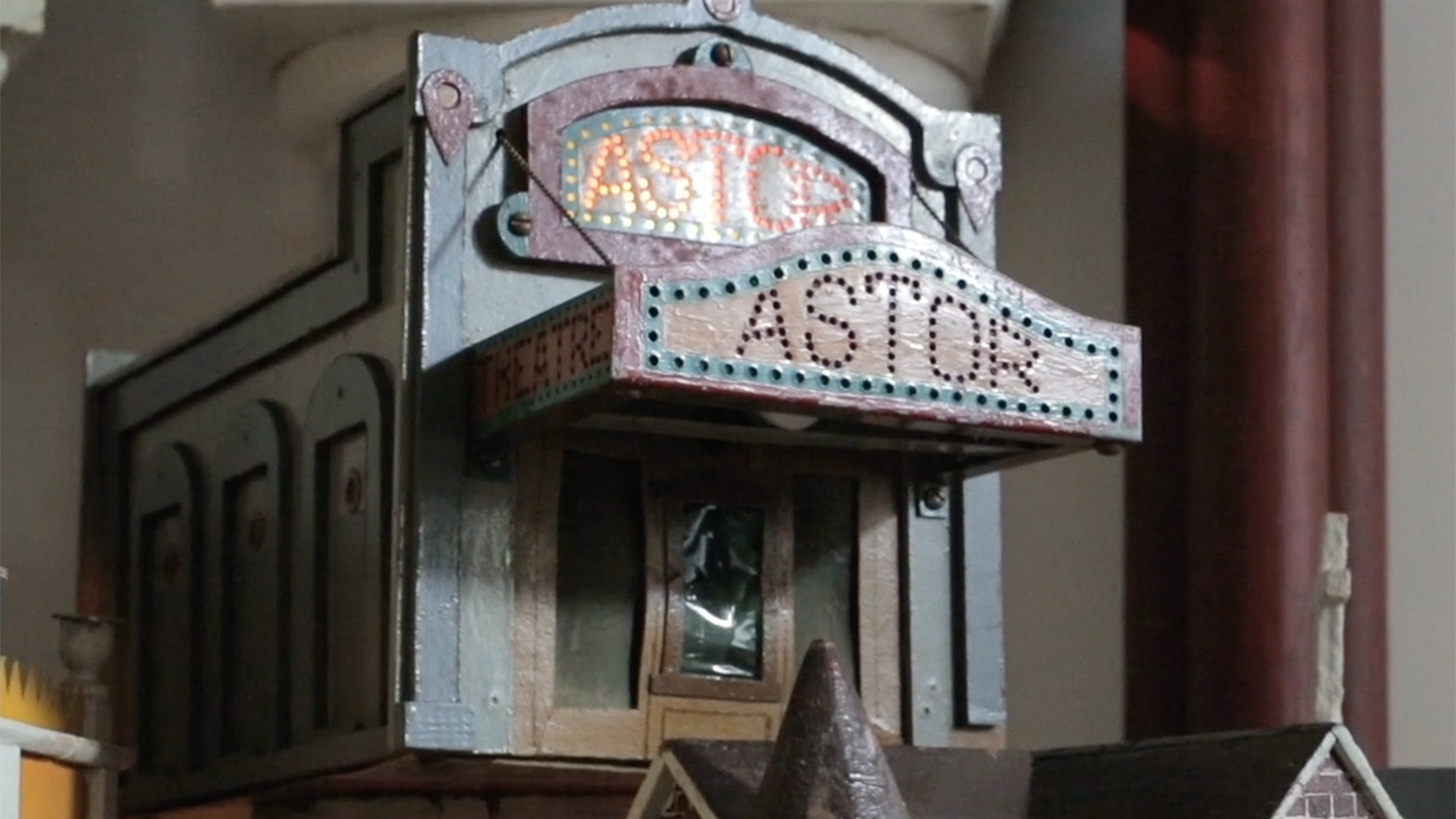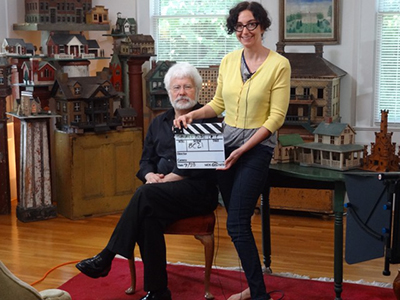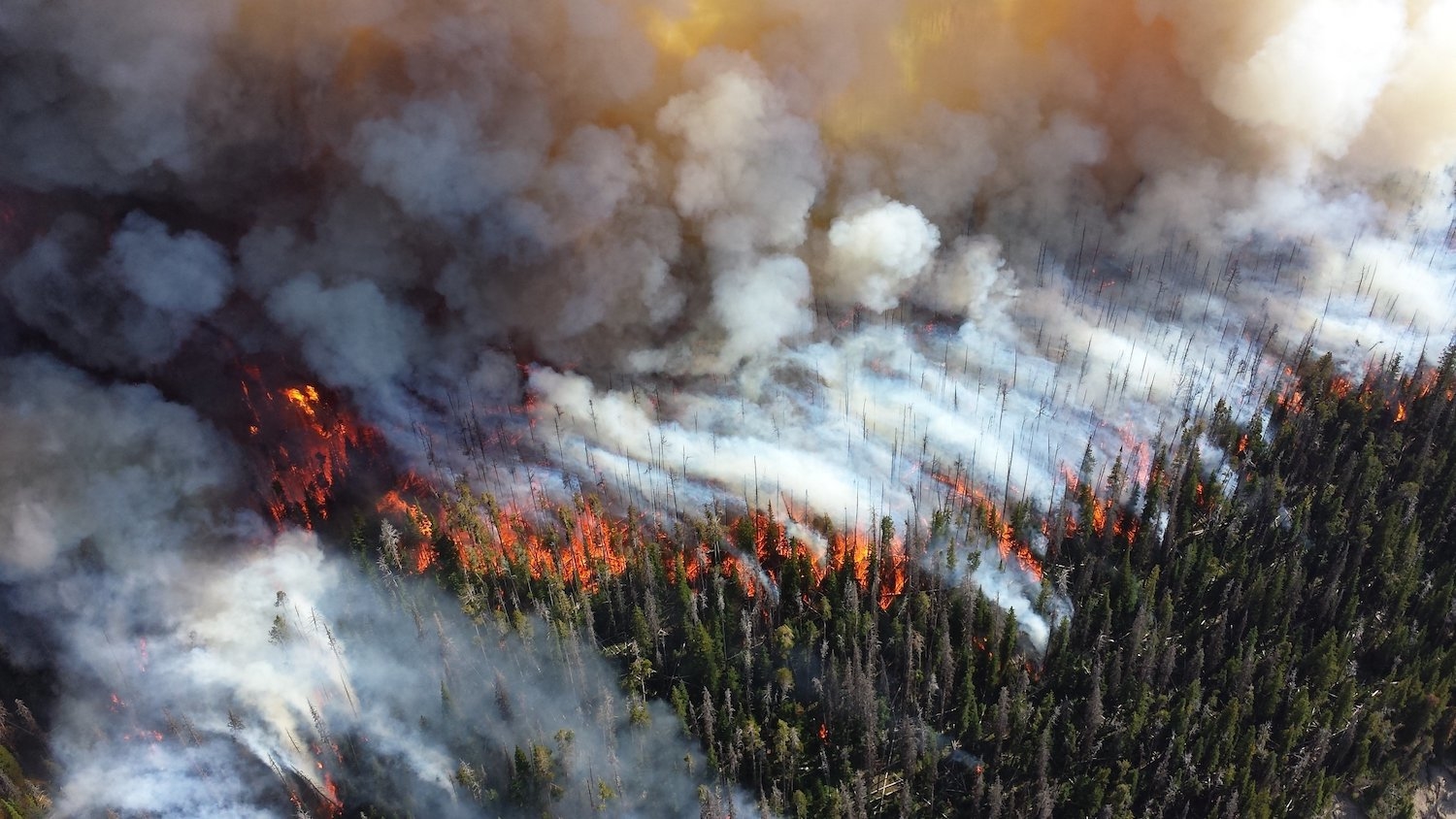Fascination and Delight: Q&A With Marsha Gordon, Co-Director of ‘Rendered Small’

Imagine a small town in North Carolina, with homes, factories, movie theaters, corner groceries and churches. It’s a quirky one, sporting the occasional castle or amusement park attraction, but what sets it apart is that this is a truly small town – the buildings are measured in square inches, rather than square feet.
This collection of small structures, and its owners, are the focal point of a short documentary film by Marsha Gordon, a professor of film studies at NC State University, and Louis Cherry, an architect based in Raleigh, N.C. (and an NC State alum).
The film, Rendered Small, first screened at the 2018 Indy Fest at the Indianapolis Museum of Art, and will screen May 11 at the North Carolina Museum of History as part of the Longleaf Film Festival.
We recently had an opportunity to ask Gordon about the film and what drew her to the scaled-down “American Folk Art Buildings” that Steven Burke and Randy Campbell have collected in their Hillsborough, N.C. home.
The Abstract: You’re a film studies scholar, and have written extensively about movies, movie-making, and movie-makers, but this is the first time you’ve actually made a movie yourself. What made you decide to move from studying films to making one?

Marsha Gordon: I’ve been studying, writing about and teaching documentary film for many years – but have never worked on the other side of the camera until very recently. I think it began with multi-media projects I started working on with my students at NC State, like “Shooting Wars,” which I did with my graduate class on war documentaries a few years ago.
While I’ve never had the desire to make a fiction film, I’ve considered documentary projects for many years. I guess I just never had the dedication, time or energy to see one of those ideas through until this project. It was a very steep learning curve, and I am really happy to have gone through the process now of seeing a documentary through from conception to existence.
TA: Making a documentary, even a short one, means devoting a lot of time to that particular subject – so it needs to be something you’re willing to immerse yourself in. What made you decide to make this movie in particular?
Gordon: This is so true – even more so than I ever could have imagined! We started out thinking that this would be an hour-long documentary and that it would take maybe a year and a half to make.
It actually it took four years – not of constant work, of course – but starting and stopping due to other commitments that often got in the way. But our love for the collection and the idea of sharing it with a larger audience kept us going. If we had not been so enamored with these small structures and with the way they are cared for by Steven and Randy, we certainly would never have finished. It really was our personal fascination and delight that made us want to do this documentary from start to finish.
TA: This movie could be a story about a vast collection of very small buildings, or it could be about a married couple who are passionate about collecting them. How did you decide to balance those things in your storytelling? Did you go into the process thinking that the movie would be mostly about the collection or mostly about the collectors? Did your thinking on that evolve over time?
Gordon: We always thought that this film was going to be both about the collection and the men who have put it together over the years and, most importantly, who live with it every day in their home. The two threads are inseparable and are equally interesting parts of the story, so those were there from Rendered Small’s inception. Collecting is always such a personal thing. Partly what was interesting about this collection was its uniqueness (in terms of the nature of the objects collected) and the way this couple has negotiated how to exist with the sheer volume of what they have collected.
TA: Burke has been interviewed by outlets from Our State to the New York Times, so clearly he’s comfortable talking about the collection. But allowing someone to shoot a documentary is a much bigger commitment than conducting an interview with a reporter. Was there any reluctance from Burke and Campbell about inviting you into this aspect of their lives? How did you win their confidence?
Gordon: I was first introduced to Steven and Randy when I co-curated an exhibition at the Gallery of Art and Design at NC State (now The Gregg Museum) in 2005. So I’ve known them and visited their collection numerous times in the intervening years.
When I first approached them in 2013 to talk about the project, they already knew how much I loved the collection, which I was taken with immediately. So I think that helped. I think it also helped that my co-director is an architect who really understands and can articulate the significance of the collection from that angle.
But make no mistake: it is a gesture of incredible trust to allow someone to film you and to spend time filming your home. I think that the finished film nicely reflects the mutual respect we have for each other.
TA: Rendered Small is a short film, coming in at 15 minutes, but that’s not necessarily an indication of how much time it takes to shoot. How many days did it take you to conduct the necessary interviews and shoot footage of the collection?
Gordon: You can say that again! We shot two six-hour days of interviews with Steven, who is the primary driver of the collection, and maybe ninety minutes with Randy. Once we had transcriptions of those interviews, I did a paper edit that became the working script for the film, which, of course, constantly evolved during the editing process.
We filmed the buildings during four different shoots (including one day of drone work and footage taken with a stabilizing camera gimbal by NC State Film Studies alumnus David Hambridge, who is now a documentary filmmaker). These shoots had long gaps of time between them because we all had so many other projects going on in our professional lives, so sometimes Rendered Small just sat for six to eight months until we could come back to it.
TA: Did your years of studying film prepare you for the editing process? I mean, that’s when you have to make key decisions about how to tell this story; which clips go in and which fall on the cutting room floor. Do you think your knowledge of film made that process any easier? Or more difficult?
Gordon: What made editing easier was having a really talented, experienced editor to work with. Kevin Wells, who is a filmmaker who also teaches film production at UNC Greensboro, came on board thanks to a connection made for us by documentary filmmaker Brett Ingram, one of our many advisors on the project. Kevin really made this documentary what it is.
Louis and I were attached to parts of the story that Kevin helped us realize slowed its pacing down. It’s easy to lose sight of film as, first and foremost, storytelling when you get focused on all the amazing information you want to convey. But it’s essential not to lose sight of that.
The more we edited the documentary down the stronger it got as a story – Rendered Small’s total run time is around 15 minutes. I think that attending Full Frame Documentary Festival for almost 15 years has taught me to really appreciate the short form documentary, and I tried to remember those lessons during editing where the structure and duration really took place. You have to learn to let go of things in the editing process, and I think we benefit from the length of our editing process as it gave us distance and perspective. Sometimes when we sat down to edit it we could really watch it with fresh eyes because of the time that had passed.
TA: There are often great scenes that get cut because they just don’t fit into the story that a film-maker is trying to tell. Is there a scene or anecdote that was particularly difficult for you to cut, but that you cut anyway?
Gordon: In our case there are dozens of scenes and stories that were wonderful but that didn’t make the final cut.
For example, Steven and Randy have hundreds of churches in their collection and Steven spoke very eloquently about the array of architectural styles and religions represented in the collection, as well as about the richly detailed interiors in many of the churches they own. That segment – which ran about 3.5 minutes – was in the film until the last few weeks of editing when we got really aggressive about the edit. We decided to drastically shorten that discussion because it bogged down the pacing, even though it’s fascinating material.
Many experienced documentary filmmakers who watched drafts of the film advised us that it’s better to leave an audience wanting to know more rather than looking at their watches. I’ve seen more documentaries than I can count that could have benefited from substantial edits down, so I tried to practice what I preach.
TA: Last question, just for fun. Having spent hours looking at hundreds of these small structures, is there one that stands out to you as a favorite?
Gordon: One? You’ve got to be kidding! I’m going to cheat on this answer: I have a soft spot for the Astor Theater, the bowling alley, and the art deco style “Fast Trains” station that Steven actually waited to open until we were there to film him doing it. I guess it’s not surprising that these all make their appearances in the film!
Editor’s Note: Interested in seeing Rendered Small? The film will be shown as part of the Longleaf Film Festival at 8:30 p.m. on Friday, May 11, at the NC Museum of History in downtown Raleigh.
- Categories:


